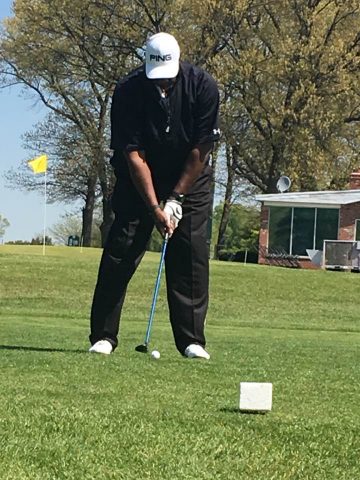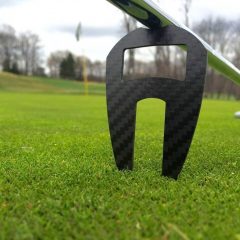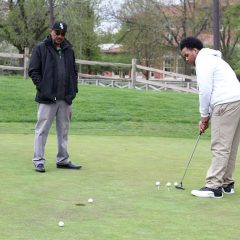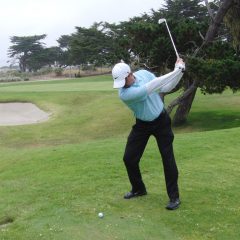Steps to Improve Your Short Game
Written By: Lovell Diggins Jr
If you’re looking at ways to lower your golf score, there’s one area most of us could be better at, but fail to put the needed time in to improving it, that’s the short game. I can tell you that there’s no worst feeling in golf than to drive a 300-yard drive right down the middle on a 450-yard par 4, miss the green on your approach shot, then duff the pitch or chip shot. What initially looked as if it was going to be a great hole for you now looks like a double bogey. Believe me I’ve been there more times than I care to remember. The following are some suggestions you can take to minimize these mistakes in 2020.
Identify the areas where your short game is suffering. There are so many different elements to the short game, but I want you to realize that even the pros miss greens. The difference with most of them, is that they have an excellent short game and are able to the majority of the time, hit a good enough shot that will allow them to save par. Now, I know that we’re not pro’s and would most likely not be able to spend the amount of time practicing that they do, so it’s even more important that the time that we do spend is laser focused and specific so we can get the most out of it. I want you to also understand that the worst thing anyone can do is to go out and practice, but not understand what they SHOULD be doing. This to me is one of the main reasons (besides not practicing) that golfers don’t get better and frustration sets in.
- What I recommend is that you take a short game lesson. Yes, it could cost you $40-$50 bucks or perhaps even more depending upon where you live, but the whole idea is to understand the correct way to hit the specific shots so you can go to the practice facility knowing how the shots are suppose to be executed and to help you develop the right muscle memory.
- OK, you’re not really feeling the lessons, that’s OK for now, but keep it in mind in the event these other methods aren’t working. My next suggestion would be to go on line and look up “Short Game Techniques”. You should be able to find numerous articles and illustrations on the various short game shots.
- Another suggestion would be to pick up one or a couple of the golf magazines out there, like Golf Digest, or Golf Illustrated to name a couple. They’re packed with articles about the game we love and will at times cover short game techniques that I’m sure you can gain knowledge from.
- Lastly, if your fortunate to know someone with a good short game, ask them for some help, or at least observe them when working on their game. The whole idea is for you to develop the right practice habits. Why? Because if you are practicing the incorrect techniques, it is those techniques that will be ingrained in you muscle memory, and you want to ingrain the correct techniques. The 4 areas in the short game to work on are: Pitching, Chipping, Sand shot, and Putting.
- Pitching, balance is very important on the pitch shot. You have to try and remain
balanced and steady. Excessive body movement can lead to a duffed shot
and if your too eager to watch the shot, you can come off the shot and hit it
thin. Keys for success are:
- Distribute your weight equally on both feet.
- Keep your body still through-out the stroke and focus in on a nice easy flowing stroke. This is a hands and arms shot.
- Keep the left wrist firm and in control of the club.
- Keep the rhythm the same for all length shots, vary the backswing for the different distances.
- Keep club face square both into and after impact keeping the head at the same height through-out the swing.

- Chipping, Improve your feel for the clubhead and control over the shot by
gripping down on the grip. This is vital to having a delicate greenside touch
- You want to have a good understanding of which shot and club will be needed to complete the shot. Is it a “Chip and Run” a “Chip and run over an Apron” or a “Chip over a Hazard”.
- You want to determine where you want the ball to bounce and focus on the spot.
- Depending upon whether your hitting the shot over a hazard or off the fringe will determine the backswing. If going over a hazard, take a sharp up in order to float the ball and drop it quickly. If no hazard, take a putter grip and stroke it like a putt.
Make sure you complete the swing by keeping your tempo. Quitting on the swing or slowing down the club head can lead to a thinned out shot.

- Sand Shot, the first thing you want to do when it comes to sand is to avoid it if possible. Keep in mind that they are there for a reason, and it’s usually to punish the golfer. The steps below are primarily for a green side bunker, but can be used for getting out of a fairway bunker as well.
- Make sure the ball is opposite the front heel, align slightly open to target and position a little more weight on the front foot than on the back foot.
- Focus on making a smooth one piece take away and keep your weight fairly even through-out the back swing.
- Make almost a full backswing and hinge the wrist a little earlier to create a steep arc.
- Pull the club down with the left hand, this allows you to strike down and ensures the clubhead doesn’t overtake the hands before impact.
- Splash down concentrating on a mark about 2 inches behind the ball. Stay down and delay the release of your hands to avoid turning the clubface over too soon.
- You’ll generate lots of clubhead speed with this swing with the ball only traveling a short distance.

4. Putting, when you think about it, close to half the strokes a golfer takes are putts, so it is worth your wild to have a good understanding of a good putting technique in order to hopefully keep the number of strokes to a minimum.
- The first thing to always try to do when putting is to avoid tension and stay loose. Staying relaxed at address is one of the keys to success.
- Position the ball inside of the forward heel, this helps to strike the ball on a slightly upward swing and create over spin.
- Maintain a light grip and take the club back smoothly low away from the ball.
- Keep both arms in the shape of a triangle through putt, keeping your wrists firm.
- Accelerate the putter smoothly into impact with ball. Remember to keep the wrist firm to ensure the hands stay in front of the putter head and to create over spin.
For more golf tips and news, visit GolfTipsLTD.com









